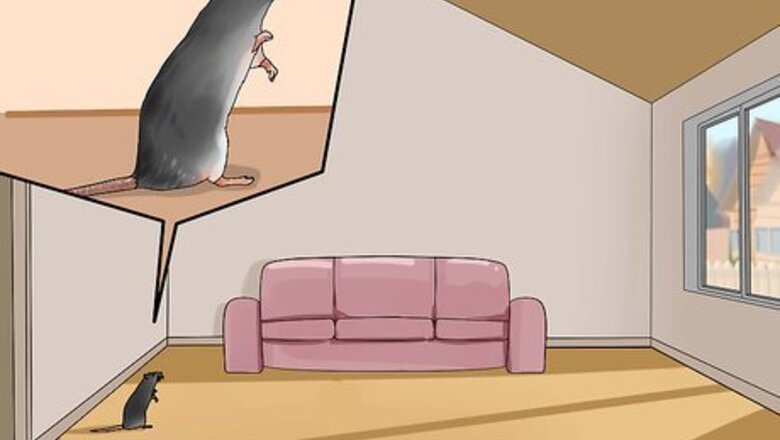
views
Preparing Your Rat for Training
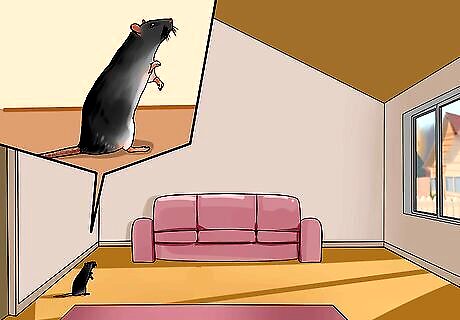
Let your rat get used to his new home. When you first get a pet rat, give him at least a week to get used to his new surroundings (and to you). Your rat needs to feel comfortable and safe before he will respond to training; rushing into this will not produce the results you're hoping for. Sit near your rat's cage for 5 minutes at a time, several times a day and talk softly to him. This will help him get used to your presence and voice. Once he knows you are not a threat, he will be more receptive to training. Avoid making loud sounds or sudden movements near your rat while he's adjusting to his new home.
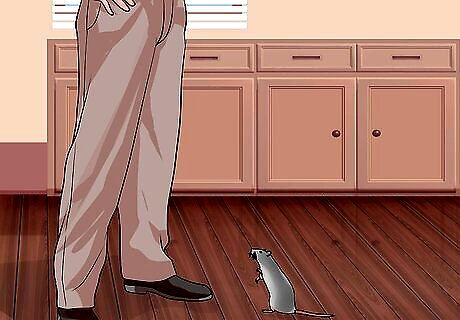
Let your rat approach you. Place a hand inside his cage while holding treat and let him come to you to get it. After doing this enough times, your rat will learn that he can trust you and will also associate you with positive feelings (from treats and affection). He will also become used to coming into contact with you, which is a prerequisite for shoulder training. Use a soft voice and handle/pet him gently when he approaches you. It could take him a while to approach you at first (several minutes), but be patient. Don't give up on this because you think it's taking too long. This could teach your rat that if he waits long enough you will go away. Once your rat is comfortable with this, hold the treat just outside his cage to get him to come out and get it.
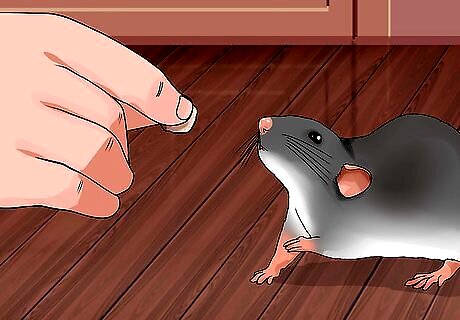
Hand feed your rat often. Ideally, you will have him take a treat from your hand every time you approach his cage for at least the first several days after beginning this process. This reinforces the association between your presence and treats and will quickly make him want to be around you. Healthy treats that rats usually love include banana chips, plain Cheerios, sunflower seeds, plain yogurt, and peas. Be careful not to overdo it with the treats; over-feeding can lead to your rat becoming overweight, which is not good for his health.
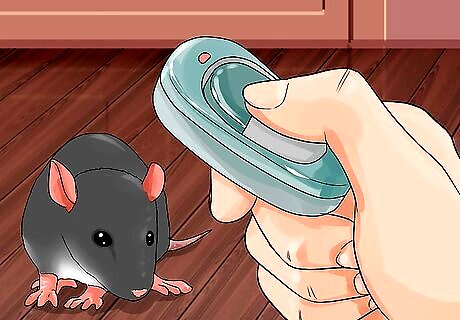
Use a clicker device. Clicker training is an effective way of teaching animals (including rats) to associate the sound from the clicker with a reward. The easily identifiable click signals to your rat that a treat is soon to come as a result of his behavior. The click sound must come immediately before the reward in order for your rat to learn this association; time this to occur just as he's about to take the treat. Your rat will learn this association most quickly if you also wait for him to do something on his own, then click and reward him immediately. This teaches your rat that he is in control of this game.
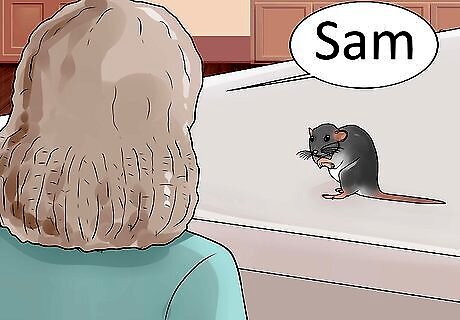
Teach your rat his name. Rats can understand simple voice commands, so long as you consistently use them. This trick helps when it comes time to shoulder train because you will be able to keep him near you just by calling his name. Say your rat's name whenever you hand him a treat. After doing this for a while, hold the treat away from him a little and say his name. Eventually, he will know to come to you when he hears his name, even if you are out of sight when you call him. Other simple verbal commands can be helpful too, such as "no" and "come." Work these in when appropriate. EXPERT TIP Brian Starr Brian Starr Rat Specialist & Breeder Brian Starr is a Rat Specialist and Breeder and the Owner of OC Dumbos out of Central Florida. As America’s only breeder of pet Roof Rats, Brian and OC Dumbos specialize in rat breeding, training, and care. Years of experience and several generations of careful breeding have allowed Brian and OC Dumbos to create a line of tame Roof Rats, bred to make friendly, fun pets. In addition to offering rat accessories and training resources, OC Dumbos also offers free Roof Rat adoptions. Brian Starr Brian Starr Rat Specialist & Breeder Reward training wins with tiny treats. Hide healthy treats around their enclosure as positive rewards to motivate them to willingly learn tricks and tasks. Treats will provide consistent, food-based reinforcement during play time.
Shoulder Training Your Rat
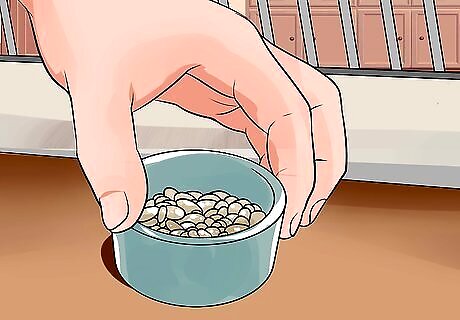
Remove your rat's food bowl from his cage. Do this an hour or so before each training session so your rat is not too full to care about treats. Place the food bowl out of sight of his cage so he is not bothered by its presence and inaccessibility. Do not deprive your rat of food otherwise! This is cruel and will not benefit training. Do not forget to put the food bowl back in your rat's cage once you are done with the training session!

Place your rat on your shoulder. Be gentle and speak to him as you do this, and make sure you are seated (ideally on a couch or cushioned chair) so your rat won't become injured if he jumps or falls off your shoulder. You should expect your rat to not want to sit still at first, as this will be a totally new experience for him. Give your rat a treat as soon as you set him on your shoulder. Use your clicker as you do this (if you decide to use this training device). Keep a hand up while your rat is on your shoulder in case he tries to jump off.
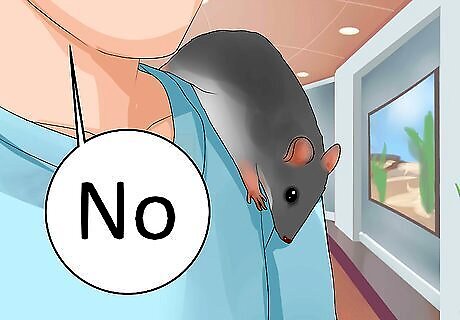
Tell your rat "no" if he tries to climb down. As you do this, also use your hand to block him from being able to get away. Your verbal command should be delivered in a firm (not scary) tone. While blocking him from climbing down, maintain a gentle touch. This is only something you should do during the initial training phase. Once your rat is used to sitting on your shoulder for a while, his desire to come down could be the result of something other than nerves -- such as the need to relieve himself! If your rat seems terrified during the first few attempts at this, don't make him put up with it for too long. A minute or two is sufficient for the first couple of tries.
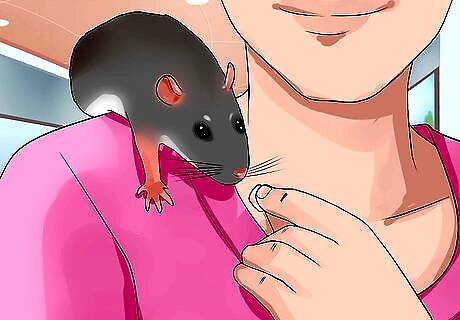
Keep the treats coming. While your rat is on your shoulder, give him a treat or pets every so often to reinforce the positive association he has with being there. If you put your rat on your shoulder and simply ignore him after that, he will become bored and try to get down. Remember to use the clicker just before giving him a treat (if you've been using it for his training already). Depending on the kind of treat you give your rat, you should expect some mess associated with his snacking. Crumbly foods like Cheerios are likely to get on your clothes, so be prepared for this. Don't move around too much when your rat is snacking on your shoulder. Rats often use their front paws to hold things as they eat them, so your rat will be more unstable while he's eating.
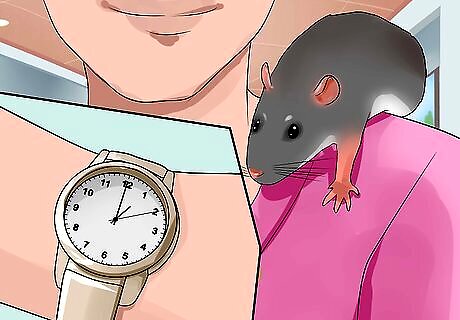
Keep the sessions short at first. Gradually build up the amount of time your rat spends on your shoulder and don't be surprised if he maxes out after a couple of minutes. Every rat is different; some will find your shoulder to be a comfy place to rest, while others won't like it no matter how much you try to train them to. Stay near his cage and remain quiet during your first few sessions. Eventually, you can venture further away for longer periods without your rat becoming overly distressed. If your goal is to be able to have your rat on your shoulder even when you venture out of the house on longer trips, let him gradually become accustomed to being outdoors; this is a whole different element of training than simple shoulder-sitting.
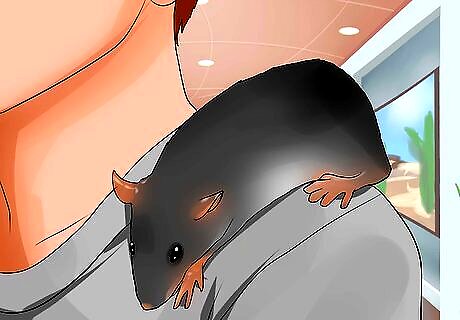
Learn to recognize when your rat wants down. Physical or behavioral cues that your rat is getting ready to climb or jump off your shoulder should become recognizable after a few training sessions. Try to let him off your shoulder before he gets down by himself; this will teach him that he can trust you to let him down and will curb his urge to bail on his own. Trust is critical for any kind of training to be successful; if you keep your rat on your shoulder too long, he won't enjoy it and will feel like you are trapping him there. Don't let this happen! Your rat should be housebroken before you begin training him to shoulder-sit. This being the case, he will likely become fidgety and nervous when he needs to relieve himself. Be sure to return him to his cage right away if you notice this behavior.
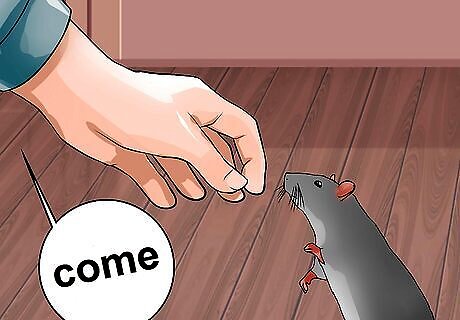
Call your rat up onto your shoulder. Once he is comfortable sitting on your shoulder for a while, you can work on getting him to come up when you call him. Be sure you are sitting down and wearing clothes he can climb on before you do this so he doesn't take an accidental fall or get frustrated while trying unsuccessfully to get to your shoulder. This is where teaching your rat to recognize his name comes in handy. If you choose, you can teach him to come to a different command, such as "come." By the time your rat is this comfortable sitting on your shoulder, you should back off on the treats and mix in affectionate petting and snuggling. This will keep your rat from becoming overweight.
Keeping Your Rat Happy
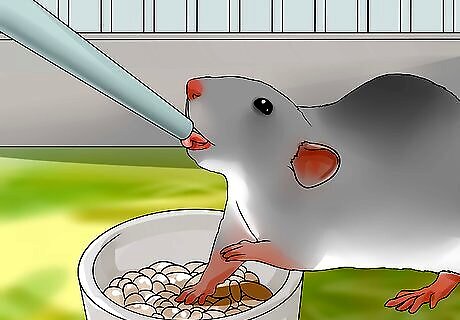
Keep your rat fed and watered. Your rat will be easier to train and have ea happier life if he has easy access to his basic needs. You should always keep your rat well-fed (not over-fed) and make sure he has constant access to clean water. Give your rat high-quality foods that contain all his essential nutrients. Some companies make blended rat foods in block form, which prevent rats from picking out only the tastier (and usually less nutritious) bits in their food. Ask your veterinarian how much/often to feed your rat based on his age and size. Remember that overfeeding can shorten your rat's life and make him lazy.
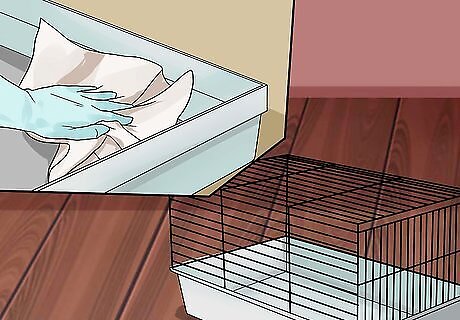
Clean your rat's cage often. Rats like to be clean, and they will become upset if their cage is too dirty. They also don't like their waste to be too close to their food and water, so keep these areas in separate corners of your rat's cage. Successful training depends in part on your rat's state of mind, so keep him happy about his environment in order to get the best results. Change cage bedding every 3 to 5 days (or more often if you have more than 2 rats in one cage). Thoroughly sanitize your rat's cage once a week. This means removing all bedding, toys, and other objects and using a pet-safe cleaner to wipe down all the cage surfaces. Don't forget to clean out and sanitize water and food dishes, too.
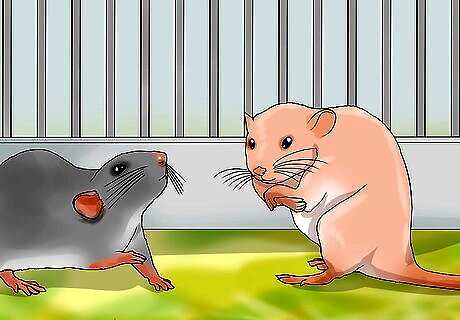
Socialize your rat. Rats are very social creatures, and they can easily become lonely or bored if they do not receive enough attention. For a happy rat, it is best to get at least two so they can keep each other company. It is best to get both (or all) of your rats at the same time as juveniles so that territoriality and aggression are unlikely to become issues. You should still pay attention to your rats frequently, even if you have several rats in one cage. Keep your rats' cage in a place where you are frequently present and they can see what's going on around them. This will keep them from feeling isolated.
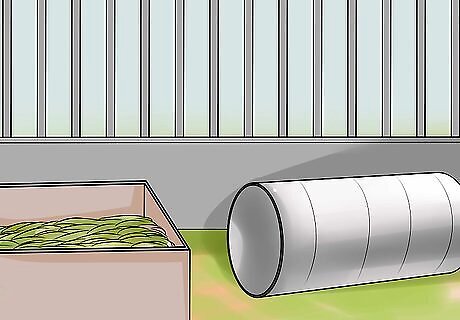
Make your rat's cage homey. Rats like to have things to climb on, hide in, and play with. This keeps them entertained and comfortable. Although you should expect your rat to chew on things in its cage, you shouldn't let cage accessories become so chewed up that they are falling apart. You don't want your rat to actually eat these things -- they aren't meant to be food! Your local pet store has lots of rat-specific items you can purchase for your pet's cage. You can easily make things your rat will enjoy, such as hammocks and cardboard tunnels. Rats like to be cozy, so be sure to include plenty of bedding material. Avoid using cedar and pine, as these materials can be toxic to rats if eaten.
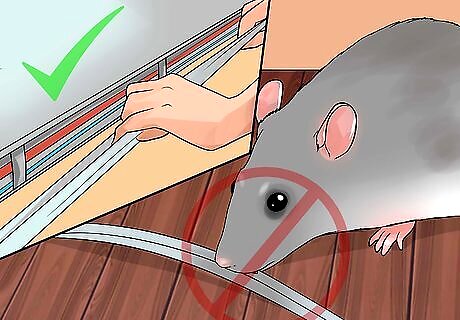
Keep dangerous items away from your rat. Because rats like to gnaw on things, don't let yours near anything that could harm or kill him if he does take a nibble or two. This means no plastic, wires, string, or anything else your rat could choke on or that is made of a hazardous materials. Don't forget to "rat-proof" the area if you have your rat roaming free outside of his cage. Mostly, this means blocking off or removing anything in the area that you don't want your rat to chew on. Keep your rat away from fabrics that can unravel into long bits of string. If your rat swallows string, he could choke.


















Comments
0 comment